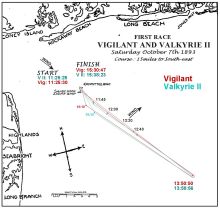 A fresh breeze came up the bay from about southwest; the sky was obscured by scudding clouds, and in the east the sun was sending rays through the rifts. Weather sharps upon the decks of outgoing vessels cocked their eyes aloft and predicted "a race to-day, sure." Some suggested that there might be sea enough outside to satisfy even the rough-weather yachts of England, but all said there would be a breeze. A fresh breeze came up the bay from about southwest; the sky was obscured by scudding clouds, and in the east the sun was sending rays through the rifts. Weather sharps upon the decks of outgoing vessels cocked their eyes aloft and predicted "a race to-day, sure." Some suggested that there might be sea enough outside to satisfy even the rough-weather yachts of England, but all said there would be a breeze.
The Vigilant in the neighborhood of Southwest Spit put her nose in the wind and began to hoist her mainsail. It took twelve minutes to set the sail. The Valkyrie started to set her mainsail at 9:30, and finished the job in ten minutes. 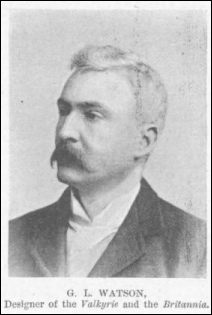 At 9:31 the Vigilant was once more headed for the lightship, with her staysail up in the stops, and men on the bowsprit to send up the working jib. The Valkyrie went out with her jib up in stops, but the forestay bare. At 9:31 the Vigilant was once more headed for the lightship, with her staysail up in the stops, and men on the bowsprit to send up the working jib. The Valkyrie went out with her jib up in stops, but the forestay bare.
Once outside the Hook, the Vigilant broke out her headsails, though she did not cast off the tow line, but kept her jib in stops until she cast off her tow, near the lightship. The Vigilant was the first to get her club topsail aloft, and the setting of the sail occupied about half an hour on each boat, and during most of that time they lay with prows in the wind, to the northward of the Scotland Lightship. As soon as the task was completed they headed straight for the starting point, and did not cast off their tow lines until they were close to it. The Vigilant was the first to get there.
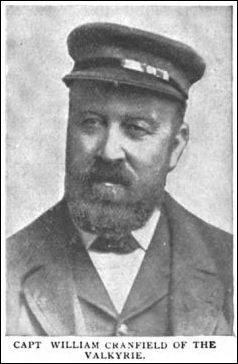 On board the Valkyrie were Lord Dunraven, the Marquis of Ormonde, Designer Watson, Lord Wolverton, Sailmaker Ratsey, Vice Commodore Archibald Rogers, of the New-York Yacht Club, who was aboard to represent the Vigilant; Pilot Martin Lyons, and Capt. Cranfield. On board the Valkyrie were Lord Dunraven, the Marquis of Ormonde, Designer Watson, Lord Wolverton, Sailmaker Ratsey, Vice Commodore Archibald Rogers, of the New-York Yacht Club, who was aboard to represent the Vigilant; Pilot Martin Lyons, and Capt. Cranfield.
While the yacht was on her way to the lightship Lord Dunraven was constantly on his feet, sometimes forward, sometimes amidships, sometimes aft looking after the sails, and evidently watching all the details of preparation. Designer Watson sat most of the time in the waist, with his feet hanging over the port rail, conversing with Commodore Rogers, who reclined upon the deck, with his back braced against the rail. Sailmaker Ratsey flitted from stem to stern, as busy as a bee. It was evident also that he had not rested on Friday, for there was a batten in the Valkyrie’s club topsail, which was not there on Thursday.
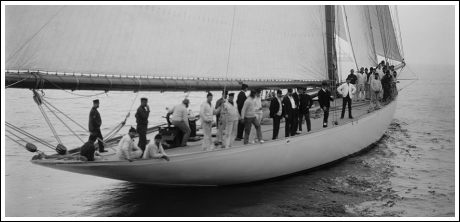
The Vigilant’s deck fairly swarmed with talent. Among the faces descried were C Oliver Iselin, Herbert Leeds, W. Butler Duncan, Jr., Edward Willard, Newberry D. Thorne, Nat. Herreshoff, Percy Belmont, Charles Kerr, Lord Dunraven's brother-in-law, the Valkyrie's representative; Capt. Terry of the Grayling, and Capt. Hansen. Nat. Herreshoff and Ed. Willard consulted together frequently on the port quarter; Mr. Iselin occasionally gave an eye to the work of the crew, while Capts. Hansen and Terry superintended the details. The guests stood or lolled about the after part of the deck, and seemed to be successfully killing time.
Before the yachts reached the lightship the flagship May went by them, under a full head of steam, with a great volume of black smoke pouring out of her funnel. She was flying the signal B, which meant that the yachts would be started on a windward, or leeward, course. The wind had been steadily hauling from southward to the westward, and when the May passed the yachts, was about due west.
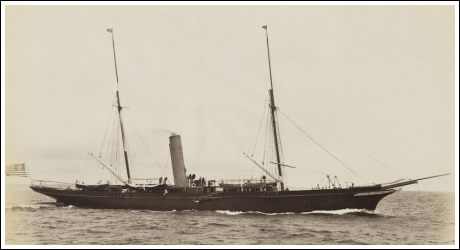
At 11 o'clock, when flagship May had come to anchor north of Sandy Hook Lightship, the wind was west by north, and she consequently displayed the signals D C G. which indicated that the course would be eat by south. At 11:07 the tug Edgar F. Luckenbach steamed off to log the course. At that time the clouds had disappeared, the sun shone bright, and there was a brilliant ruffle upon the ocean swell.
The preparatory signal was given at 11:15, and the yachts then had ten minutes to maneuver before crossing the line. The wind was not as fresh as it had been earlier in the morning, but there was a nice wholesail, perhaps eight-knot breeze. The yachts took positions north of the flagship, the Valkyrie nearer at hand. The Vigilant had her spinnaker pole in position some time before, but the Valkyrie did not lower hers until after the preparatory signal.
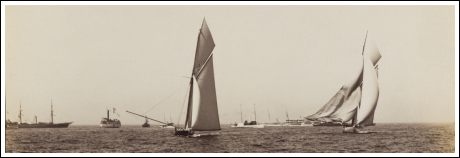
There was some skillful play for position, and the yachts forced each other about several times. Spinnaker poles were carried to starboard and were elevated to an angle of 45 degrees, so as to admit of the yachts going on the port tack. The Valkyrie’s aim was evidently to get on the weather quarter of the Vigilant, but Nat Herreshoff, who was again at the latter’s wheel, would not allow it, and so they stood on and off, dodging around each other for fully nine of the ten minutes allowed for maneuvering. Then they came down for the flagship, heading on a course about south by west, the Valkyrie leading, the Vigilant slightly to windward.
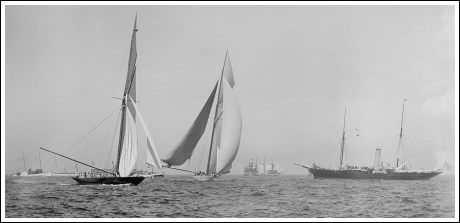
And now came as pretty a start as was ever seen. Both bore away at the flash of the gun and crossed the line twenty seconds later, the Valkyrie leading by her nose. The maneuvering had been done with working headsails, but the Vigilant broke out her balloon jib topsail just before she bore away. It was not the same sail she carried on Thursday, but smaller. Immediately on bearing away she broke out her spinnaker, but by some accident the sail got afoul of the spinnaker pole topping lift, and several minutes were lost in freeing it.
The Valkyrie did not send up her spinnaker until she was on the line, and as it filled free it drove her right to the front. Right here, also, was put in evidence the fact that Capt. Cranfield had been reading The Times’s criticism of Thursday's race, for, instead of an intermediate jib topsail, which he used that day, he sent up a balloon.
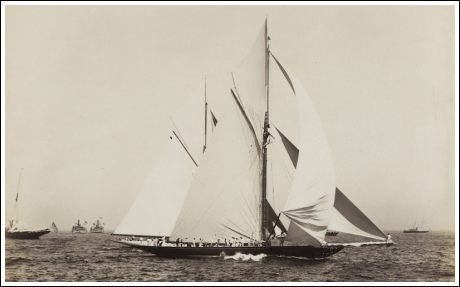
After the Vigilant’s spinnaker had been righted, it was not hauled far enough aft, and for some time did not draw well. Capt. Hansen, also, evidently soon became dissatisfied with the work of his second balloon jib topsail, for at 11:30, just five minutes after the start, he took it in, preparatory to setting the larger sail. The change was made in five minutes, which was creditably quick work, showing that the crew was well drilled.
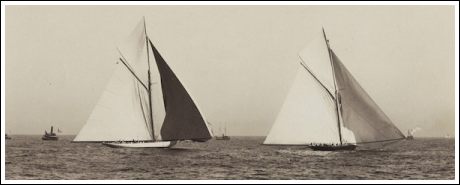
All this time the Valkyrie had been drawing ahead, and at 11:44, when about two miles from the lightship, a clear space of water, equivalent to several lengths, was between her taffrail and her adversary’s bowsprit. Her spinnaker was sheeted much further aft than the Vigilant’s, and was consequently drawing much better. The yachts were going through the water, despite the lightness of the wind, at the pace of about six miles an hour, and the aspect seemed somewhat hazy for the cup defender. But those aboard of her were not unwatchful, and the secret of the Valkyrie’s gaining was soon discovered. The spinnaker sheet was trimmed in, and the yacht moved with new life. At 11:55 it was apparent that she was closing up the gap between herself and the Englishman. The assertion was hotly contested at first, but the doubting ones had to admit ten minutes later that the Vigilant was walking to the front.

It was not a slow or spasmodic, but a steady and a rapid gain. The gap could be seen to narrow momentarily. The Valkyrie put out a huge sign “Keep off our weather quarter," though it was difficult to see what boats were troubling her, as they were all apparently keeping at a respectful distance. The sign was out but a few seconds, yet in those few seconds the Vigilant had closed up the gap and was lapping the challenger's port quarter with her bowsprit. A minute or two later bowsprit was lapping bowsprit. Then the Valkyrie’s bowsprit fell further and further aft along the white hull and at length was making a stern chase.
The breeze was freshening somewhat and the Vigilant kept running away from the Valkyrie like a witch. The latter trimmed her spinnaker further forward, but to no purpose. Then she took in her jib, which she had been carrying over the balloon jib topsail, but that did not do her any good. The slippery Vigilant was running away from her, as if helped by an invisible tow.
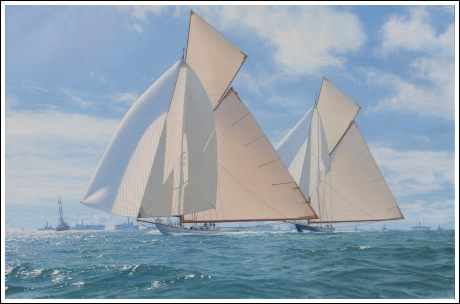
It was noticed meanwhile that the Vigilant rode the swell far more easily than the Valkyrie. She was as steady as a church, bowing easily and gracefully, making no fuss in the water, and seldom spilling the wind out of her spinnaker and balloon jib topsail, while the Valkyrie continually dipped her nose until the bowsprit almost touched the water, and shook her sails until they spilled the wind. At 12:20 the wind had hauled to west by south and was freshening. Six minutes later the Vigilant took in her spinnaker and after another minute the Valkyrie followed suit. The Vigilant set a balloon staysail, while the Valkyrie hurt herself by hanging on to her jib, which interfered with the drawing of her balloon jib topsail. At 12:30, however, she took in the jib, but did not set a staysail. After an interval of six minutes she sent up the jib again in stops, but did not break it out.
The wind showed a disposition now to be fitful, as well as changeable. At 12:20 it was freshening; at 12:30 it fell again. At 12:40 it had hauled far enough westward again with the Valkyrie to enable her to reset her spinnaker. The stakeboat was now in sight, and the Vigilant was fully a mile ahead. Ten minutes after the Valkyrie had felt the change of wind it reached the vigilant and she also reset her spinnaker. Between 12:50 and 1 o'clock the wind fell light with the Vigilant, and the Valkyrie, which had a little better breeze, gained slightly. By 1:10, however, the Vigilant had more wind and was drawing ahead again. At 1:23 she took in her spinnaker and bowled along merrily under the pressure of her enormous balloon jib topsail. The Valkyrie held on to her spinnaker for seven minutes longer, and it did her good service until she was compelled to take it in by the same shift of wind that the Vigilant had run into. The wind was now southwest and freshening momentarily.

The Vigilant was now close to the outer mark, which was obscured by surrounding excursion craft, and at 1:40 set her jib in readiness for rounding. The staysail followed a minute or two later. Still she held on to her balloon jib topsail to the last minute, and it did not come down until she had gone about for the home stretch. By the time she reached the mark there was a fine sailing breeze. It was blowing fully 15 knots an hour, but, unfortunately, was in the wrong quarter for a thrash to windward. As it stood it made a close reach back to the lightship, and that was not according to the program.
The Vigilant went around the outer mark at 1:50:50. According to the rules, she had to leave it on the starboard hand, and as she passed it she went about and sent her boom to port, at the same time trimming the sail flat. In the fresh breeze she started on the close reach home faster apparently than she had gone to the mark on the broad reach. She had covered the first half of the course in 2 hours 25 minutes 50 seconds, and certainly beaten the Englishman in handsome style, for the latter was more than a mile in the rear.
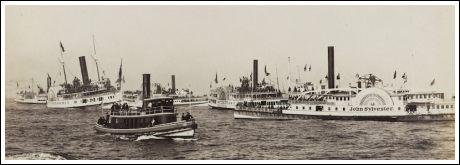
It is needless to say that her success was signalized by a perfect pandemonium of steam whistles. When the noise had died out, the first question that everybody asked was, “How many minutes is the Valkyrie behind?"
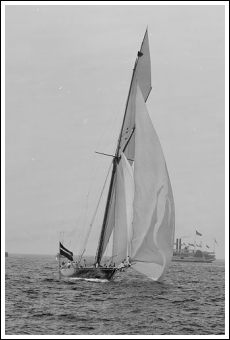 It took longer to answer the question than many supposed. She followed the cup defender around the mark at 1:58:56, so that she was beaten 8 minutes 6 seconds. When the difference was seen in figures, nobody doubted for an instant that the race belonged to the Vigilant. Nevertheless, the plucky Valkyrie was given a generous mead of encouragement in the way of tooting.
It took longer to answer the question than many supposed. She followed the cup defender around the mark at 1:58:56, so that she was beaten 8 minutes 6 seconds. When the difference was seen in figures, nobody doubted for an instant that the race belonged to the Vigilant. Nevertheless, the plucky Valkyrie was given a generous mead of encouragement in the way of tooting.
It was now a reach back to the finishing line. The wind was from the southwest and the course was west by north, so that the yachts could sail five points off the wind. This enabled them to sail about one point free. The Vigilant had set her jib and forestaysail before rounding the mark and after rounding prepared to get out her jib topsail. She hoisted it up in stops and broke it out at 1:57, having taken six minutes and ten seconds to get the sails set. It was an intermediate jib topsail, and seemed to draw well at once, for the yacht made good headway and seemed to be opening up the gap between her and the Valkyrie. She was certainly getting away from the mark faster than the Valkyrie was approaching it. |
|
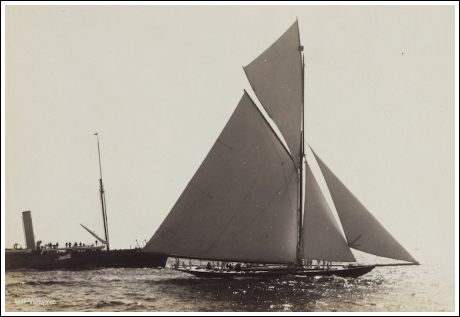
The Valkyrie was just eight minutes and six seconds behind the Vigilant at the mark. She rounded and set her small jib topsail just three minutes and thirty-four seconds after passing the stake. Sheets were trimmed down pretty flat, and the English cutter started out for a long stern chase. The wind by this time had increased to a good whole-sail breeze, and it looked as though the reach to the finishing would be made in quick time.
A reach, it has been said, is the Englishman's strong point, and everyone looked to see it gain considerably on the Vigilant, while some of the most enthusiastic admirers stated, and were even ready to bet, that it could yet beat the American boat. The Vigilant was going very fast. She went through the water without making much motion and was as stiff as a church in the strengthening breeze. The Valkyrie was more than a mile astern, but she, too, was crowding through the water at a great rate. She made hardly as much fuss as the Vigilant, having but a small wave under her bow when she left the water with hardly a ripple on it. She, too, was standing up very swiftly.
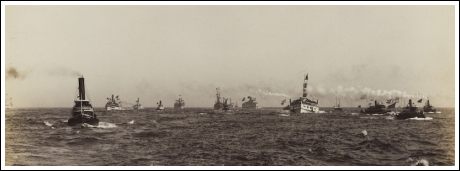
The big fleet of steamers and excursion boats that were out had waited until the Valkyrie had turned the stakepost, in order to give her a salute almost as good as the one they gave the Vigilant, and then they started off to try to overhaul the racers, in order to be in at the finish, but they had a job a little harder than they had calculated on, and it was only some of the very fastest that were able to cut down the lead which the Vigilant had gained. The others had to be content in getting a good view of the boats as they were sailing ahead of them.
The Vigilant seemed to have made a mistake in setting her big jib topsail, for the sail was evidently heading her off some, and after carrying it for about half an hour she took it in and set a small one, about the size of the Valkyrie’s. This sail did better, but it did not help her to keep the big lead that she had gained on the Englishman in the run out.
The Valkyrie was slowly but surely gaining. She crept up inch by inch, and the cuttermen who were on board the steamers watching the contest became jubilant, as they thought of the possibility of their champion winning after all. The wind by this time was stronger than ever, and if it had only been so all the morning one of the greatest yachting contests of the season, if not of the age, would have been witnessed.
It was certainly exhilarating and pleasing to watch the two boats rushing through the water and making fast headway toward the lightship. It was a test, too, of the merits of the yachts on this particular point of sailing, but it was disappointing to think that all through the morning the wind had been casting from the west to the southwest and back again, and had been blowing sometimes just enough to fill the spinnaker and sometimes had left the boats almost becalmed.
At 2:23 o'clock, after having sailed about half an hour on the homeward course, the Valkyrie trimmed in the main sheet a little. The wind was still blowing freshly, and the English boat fairly flew through the water. The Vigilant all this time was not by any means going slowly, but was not going as fast as the Englishman. She presented a beautiful picture. Every stitch of canvas was drawing well, and the American champion proved that she was a beautiful sailor on the wind.
Several of the leading steamers had by this time got alongside the Valkyrie, and one or two of the tugboats had run in rather closely to the English cutter. Those on board waved their hats to the intruders to keep off, but they evidently did not understand the signals, for Mr. Watson held up one of his many signs to them. It read: “Your wash hurts." The tugboat Captains took the hint and at once got out of the way.
Seeing the two champions tearing through the water with every stitch of canvas drawing and every rope seeming strained in eagerness to push the yacht nearer and nearer toward the finishing line seemed to cause a racing fever among the attendant steamers. 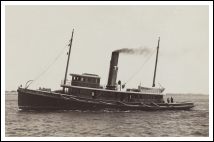 The big tugboat Kate Jones started out to beat all the other tugboats in the harbor. She had an easy job with every one of them except the McCauley from Philadelphia, and after a little tussle took the lead and was the first boat to finish. The big tugboat Kate Jones started out to beat all the other tugboats in the harbor. She had an easy job with every one of them except the McCauley from Philadelphia, and after a little tussle took the lead and was the first boat to finish.
The May, the flagship, had to be at the finishing line in order to take the time of the yachts as they crossed, and she had a hard time getting ahead of the fleet, and for a while it looked as though she would not be there. 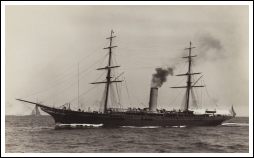 The big Valiant, Mr. Vanderbilt's steamer, was also hustling along ahead of the May, and if the flagship had not got there in time the Valiant would have taken the finishing of the two racers. The big Valiant, Mr. Vanderbilt's steamer, was also hustling along ahead of the May, and if the flagship had not got there in time the Valiant would have taken the finishing of the two racers.
About 3 o’clock the wind began to drop. It was much lighter than it was when the yachts started for home, and they began to lose the great rate of speed which they had maintained during the past hour. They had gone by this time about eleven miles, and the Valkyrie had cut down the Vigilant’s lead to about half what it was when she was at the outer mark. The Lightship was in plain sight, and it was seen that the yachts stood a little too far to the southward in the reach back.
At 3:12 the Valkyrie took in her forestaysail and set her balloon staysail. She eased off her main sheet a little, and with the wind just forward of the beam, headed for the finishing line. The Vigilant held on the reach three minutes longer than the Valkyrie did, and at 3:15 o'clock she, too, eased off her sheet and stood for the finishing line. At 3:15:30 the Valkyrie lowered her jib topsail. It had scarcely begun to flutter down on the bowsprit when the Vigilant followed her example, and the two sails came down together.
The Valkyrie had her balloon jib up much quicker than the Vigilant. It was quickly run up and filled at 3:17, while it was a minute later when the Vigilant's balloon jib topsail was helping her on her journey toward home. Both yachts set their small balloons, but they drew well, and, although the breeze was lightening considerably every minute, they made good headway toward the mark. As the sun shone on the Vigilant’s balloon, it could be seen in their hurry to get it up in position they had let the foot of it drop in the water and it made a big black daub on the silken sail.
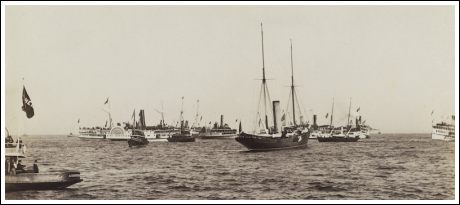
By this time many of the big steamers had taken up their position at the line. The May had anchored at the northward of the lightship and the Regatta Committee on board were shouting to the boats round about to clear the lines for the finish. Several steamers had taken up position between the lightship and the May and they seemed to expect that the racing yachts would come along and pick their way out between them and then work their way up toward the harbor. After considerable shouting and tooting of the steam whistle on the May the line was got pretty clear, but even then one or two tugboats ventured out between the May and the lightship in order to get a better view of the yachts.

By this time the wind had hauled toward the west and was backing the Vigilant’s balloon jibtopsail. It was nip and tuck whether she would be able to carry it and finish, or whether she would not have to take it in and tack to the line. She had lots of time to spare and could afford to lose a few seconds, and, keeping up her big sail, came down majestically to the finish line. She crossed at 3:30:47, and the crowd of sightseers on the excursion steamers was so anxious to salute the white beauty that they couldn't wait for the May to give the signal that she had crossed the line, but as soon as it seemed to them that she was between the May and the Sandy Hook Lightship they started yelling and cheering as if everyone had gone crazy. The steamers tooted their whistles, the bells were rung, yachts fired their guns, and some tired rockets to salute the boat that had successfully defended the America's Cup in the close race.
As soon as she had crossed the line the Vigilant lowered her balloon jibtopsail, and then stood on toward the point of Sandy Hook looking for her tender, the tug Commander. The Commander was some distance behind, but tried to keep up with the white centre-boarder, but the Vigilant had run right away from it. In the meantime the Valkyrie was fast approaching the line, and the steamers were getting ready again to give the Englishman a salute, after having made such a plucky fight under unfavorable circumstances for the first race of the series. Those on the May had the same trouble again to get the line clear. The Commander was the first tug to get in the way. Her Captain in his eagerness to catch the Vigilant, seemed to have forgotten that the Valkyrie was close up, and that he would get in her way.
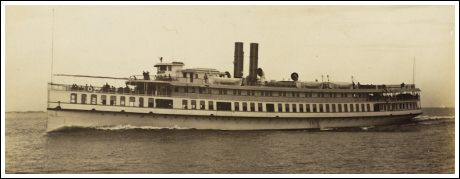
The Valkyrie was just about 200 yards from the finishing line when the big steamship Monmouth started to go between the flagship and the lightship. The Monmouth throws a wave several feet high, and this swell coming in contact with the racing yachts would necessarily retard their progress. On the flagship they shouted to the boat to keen out of the way, but she kept right on her course. The Valkyrie had come on so fast that she was on the port side of the Monmouth, but the big steamship had effectually cut off the view from those on the flagship from Lord Dunraven's cutter.
“Keep off the line” shouted ex-Commodore Kane, ”we can't see to take the time.”
“Well, we want to get up to the city” came the shout back from the pilot house of the Monmouth.
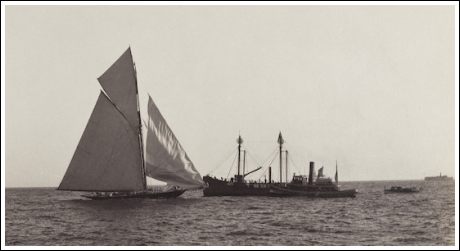
The Valkyrie crossed the line with the Monmouth, and the Regatta Committee had to guess at the time. The same yelling and whistling and shooting and noise greeted the English boat, and then all the boats started off for the city, the tug Luckenback having taken the Valkyrie in tow as soon as she dropped her balloon jib topsail.
The Monmouth belongs to the Jersey Central Railroad, of which Mr. J. Roger Maxwell, one of the most prominent yachtsmen of this section, is President. It might be well if Mr. Maxwell would instruct the Captain of the Monmouth to keep out of the way of the racers. His action in passing the line just as the Valkyrie was crossing was, to say the least, very discourteous.
In running from the outer mark to the finish, the Valkyrie had occupied 1 hour 39 minutes and 27 seconds, the Vigilant had taken 1 hour 39 minutes 57 seconds, so that the English boat had beaten the Vigilant just 30 seconds on the fifteen-mile reach. She would undoubtedly have been closer up at the finish had the wind not dropped just as the Vigilant finished the race. The Vigilant carried a fair breeze right to the finish, but after she had crossed the line the wind lightened considerably in force, and the Valkyrie suffered in consequence. The average time on the reach home was 6 minutes and 40 seconds a mile for the Vigilant and a fraction better for the Valkyrie. Considering the force of the wind, it was very fast traveling.
The following is the table:
| |
Start. |
Finish. |
Actual
Times. |
Corrected
Times. |
| |
H. |
M. |
S. |
H. |
M. |
S. |
H. |
M. |
S. |
H. |
M. |
S. |
| Vigilant |
11 |
25 |
00 |
3 |
30 |
47 |
4 |
05 |
47 |
4 |
05 |
47 |
| Valkyrie |
11 |
25 |
00 |
3 |
38 |
23 |
4 |
13 |
23 |
4 |
11 |
35 |
So, the Vigilant wins, on the corrected time, by 5 minutes and 48 seconds.
The following tables show the elapsed time for each yacht over each leg of the course:
From the start to the outer mark:
| |
Start. |
Outer Mark. |
Actual
Times. |
| |
H. |
M. |
S. |
H. |
M. |
S. |
H. |
M. |
S. |
| Vigilant |
11 |
25 |
00 |
1 |
50 |
50 |
2 |
25 |
50 |
| Valkyrie |
11 |
25 |
00 |
1 |
58 |
56 |
2 |
33 |
56 |
From the outer mark to the finish:
| |
Outer Mark. |
Finish. |
Actual
Times. |
| |
H. |
M. |
S. |
H. |
M. |
S. |
H. |
M. |
S. |
| Valkyrie |
1 |
58 |
56 |
3 |
38 |
23 |
1 |
39 |
27 |
| Vigilant |
1 |
50 |
50 |
3 |
30 |
47 |
1 |
39 |
57 |
The Valkyrie was escorted up to her anchorage off Bay Ridge in royal style. The steamers and tugs sailed along on either side of her, forming two long lines, and, as they passed her, every one whistled a salute, while the passengers on board waved their hats and cheered. The Commander, the tugboat that was towing the Vigilant, seemed to use more steam in answering these salutes than she did in working her engine, and Mr. Iselin and his friends on board were constantly bowing and raising their hats in acknowledgment of the salutes.
While the Vigilant, the victor of the race, was receiving such an ovation, the Valkyrie was by no means neglected, and every boat that passed her whistled and the passengers on board gave her a great cheer. While she was the defeated boat in the race, she was by no means disgraced. She had sailed a great race, the best race, under the conditions, that has ever been raced by a challenger for the America's Cup.
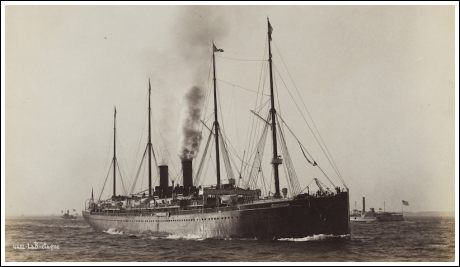
The big ocean steamer La Bretagne passed down the bay while the racers and their attending fleet were on their way up. The big steamer tooted three loud whistles as she passed the yachts, and dipped her colors to both the American and the English boats. When near Bay Ridge the Valkyrie had closed up on the Vigilant, and as the two boats drew alongside, Capt. Cranfield lined his men up, and they gave three rousing cheers for the Vigilant. The cheers had hardly died away before Capts. Hansen and Terry had lined the crew of the Vigilant up, and, aided by Mr. Iselin and his friends who were on board, three cheers and a tiger were given for the Englishman.
The boats reached their anchorage by 5:30 o'clock, and by that time everything was made snug on board the yachts. The yachtsmen went ashore, and the sailors, after getting their stores back on board again, had their suppers and talked over the day's race.
So ended the first race of the series of 1893 for the America's Cup.
|
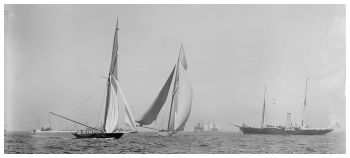 THE VIGILANT DEFEATED THE VALKYRIE BY 5 MN 48 S.
THE VIGILANT DEFEATED THE VALKYRIE BY 5 MN 48 S. Copyright © The New York Times - Published: October 8, 1893 - The yachts left Bay Ridge in tow under bare poles before 8 o'clock. The white star tug L. Pulver had the Valkyrie, while the Commander, with Mr. Iselin’s colors flying from the bow flagstaff and on both sides of the pilot house, towed the Vigilant.
Copyright © The New York Times - Published: October 8, 1893 - The yachts left Bay Ridge in tow under bare poles before 8 o'clock. The white star tug L. Pulver had the Valkyrie, while the Commander, with Mr. Iselin’s colors flying from the bow flagstaff and on both sides of the pilot house, towed the Vigilant.
